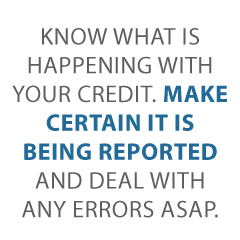- Connect With Us!
- (877) 600-2487
- info@creditsuite.com
5 Easy Ways to Manage Your Business Credit Profile
Published By Janet Gershen-Siegel at April 22nd, 2018
Easy Ways to Manage Your Business Credit Profile and Beat Your Competition
Do you need to manage your business credit profile? We’ve got five great ways to do so. So, you can get started today. Managing your business credit will make it easier for you to get loans and credit. And you will get better terms for both.
It can also mean the difference between wanting company credit and loans, and not getting them at all. So here are five straightforward methods to manage your business credit.
Easy Ways to Manage Your Business Credit Profile: 1. The Credit Reporting Bureaus Can Get It Wrong
Know what is happening with your credit. Make certain it is being reported and deal with any errors ASAP. Get in the habit of looking at credit reports and digging into the specifics, not just the scores.
We can help you monitor business credit at Experian and D&B for only $24/month. See: https://oldcs.creditsuite.com/business-credit-monitoring. Update the details if there are mistakes or the information is incomplete.
And while you’re at it, monitor the CRA which only deals with personal and not commercial credit. So that is TransUnion. If you do not know the way to pull a credit report, do not stress. It is simple.
Easy Ways to Manage Your Business Credit Profile: 2. Stay on Top of Your Small Business Credit Scores
This you should get and review your business and consumer credit reports often. For new companies and sole proprietorships, credit bureaus often also check consumer credit.
That’s why you should stay on top of both sets of scores. Credit scoring reports can have errors and you have the right to dispute them. But you will not know there are any mistakes unless you check.
Disputing often means sending a paper letter with copies of any proofs of payment with it. These are often receipts and/or cancelled checks.
Never send the originals. Always send copies and keep the originals. Detail any charges in dispute. Make certain to use certified mail so you will have proof that you sent your dispute.
Easy Ways to Manage Your Business Credit Profile: 3. Do Your Best to Improve Your Payment History
How do you make your company’s payment history better? It’s simple. Pay your bills on time and in full. You need to keep your personal spending within your means. And you also must keep your small business spending realistic.
No one can predict the future. All anybody can do is to go by whatever information is available. So, don’t be more optimistic than the facts warrant. For new businesses, that should mean evaluating industry trends. For businesses that are not so new, it means scrutinizing your business’s performance. This ought to be under all sorts of circumstances.
Don’t Gamble on Your Business’s Future
Hence if it looks as if your business could make $1 million next quarter, but you need cash now, do not borrow beyond $1 million. And you most likely should borrow even less than that. Keep company spending in check and don’t bet the company’s future on a hunch. These are great ways to get your credit balances down. Plus, that will improve your payment history.
Consider that anything could happen. Your biggest supplier could go out of business, or your best worker could quit. Or important crops could fail, or setbacks could happen. Being daring in business can often be a good idea. But you still need to pay your small business’s bills.
Easy Ways to Manage Your Business Credit Profile: 4. Credit History Length Matters
This is how long your company has been taking advantage of business credit. Of course, newer businesses will have short credit histories. While there is not a lot you can do about that and there’s no real hack for that, per se, do not despair.
CRAs will also review consumer credit scores and your history of payments. If your personal credit is good, with a long credit history, it helps. Your consumer credit can come to the rescue of your business.
The opposite is also true. If your personal credit history is poor, it will influence your company credit scores. This will happen until the separation of your small business and consumer credit.
Easy Ways to Manage Your Business Credit Profile: 5. Do Not Let Your Credit Utilization Rate Affect Your Small Business
Credit utilization rate means the quantity of money you have on credit. It is then divided by your total available credit. Lenders do not want to see this go above 30%. So, for every $100 in credit, do not borrow on over $30 of that. If this percent is rising, you’ll need to spend down and pay your debts before borrowing more.
Learn more here and get started toward building business credit attached to your company’s EIN and not your SSN.
Bonus: How to Build Business Credit
Business credit is an asset which can help your small business for many years to come.
The Process
Building business credit is a process. It is not automatic. A company needs to work to establish company credit. Still, you can do it easily and quickly. It is much quicker than establishing individual credit scores. Merchants are a big part of this process.
Carrying out the steps out of sequence will cause repetitive denials. No one can start at the top with business credit. For instance, you can’t start with store or cash credit from your bank. If you do, you’ll get a denial 100% of the time.
Business Fundability
A business must be respectable to lending institutions and vendors. Hence a corporation will need a professional-looking website and email address. It should have site hosting from a vendor like GoDaddy. And, business telephone and fax numbers should have a listing on ListYourself.net.
Plus, the company telephone number should be toll-free (800 exchange or the like).
A corporation will also need a bank account devoted to it alone. And it needs to have all the licenses essential for operation. These licenses must be in the complete, accurate name of the business. They must have the same company address and telephone numbers. Bear in mind that this means federal and state licenses. But it could also mean city licenses.
Working with the Internal Revenue Service
Visit the IRS web site and get an EIN for the small business. They’re free. Choose a business entity like corporation, LLC, etc. A business can start as a sole proprietor. But it will most likely want to switch to a variety of corporation. This is to limit risk and take full advantage of tax benefits.
A business entity matters for tax obligations. And it will matter for liability in the event of litigation. A sole proprietorship means the owner is it when it comes to liability and tax obligations. Nobody else is responsible.
If you are as a sole proprietor at the very least be sure to file for a DBA. If you do not, then your personal name is the same as the company name. Hence, you can wind up being responsible for all company debts.
Plus, per the IRS, using this arrangement there is a 1 in 7 possibility of an IRS audit. There is a 1 in 50 chance for corporations! Avoid confusion and lower the odds of an Internal Revenue Service audit as well.
Starting Off the Business Credit Reporting Process
Start at the D&B web site and get a free D-U-N-S number. A D-U-N-S number is how D&B gets a small business into their system, to generate a PAYDEX score. If there is no D-U-N-S number, then there is no record and no PAYDEX score.
Once in D&B’s system, search Equifax and Experian’s websites for the business. You can do this at https://oldcs.creditsuite.com/reports/. If there is a record with them, check it for correctness and completeness. If there are no records with them, go to the next step in the process. By doing so, Experian and Equifax will have something to report on.
Vendor Credit Tier
First you should establish trade lines that report. This is also known as the vendor credit tier. Then you’ll have an established credit profile, and you’ll get a business credit score.
With an established business credit profile and score you can start getting retail and cash credit.
These accounts are often for things bought all the time, like shipping boxes.
But to start with, what is trade credit? These trade lines are credit issuers who will give you initial credit when you have none now. Terms are often Net 30, versus revolving.
So, if you get $1,000 in vendor credit and use it all, you must pay that money back in a set term. For example, pay back within 30 days on a Net 30 account.
Details
You must pay Net 30 accounts in full within 30 days. For Net 60 accounts, you must pay them in full within 60 days. Unlike revolving accounts, you have a set time when you must pay back what you borrowed or the credit you made use of.
To launch your business credit profile the right way, you need vendor accounts that report to business CRAs. When that’s done, you can then use the credit.
Then repay what you used, and the account is on report to Dun & Bradstreet, Experian, or Equifax.
Not every vendor can help like true starter credit can. These are vendors that will grant an approval with marginal effort. You also need them to be reporting to one or more of the big three CRAs: Dun & Bradstreet, Equifax, and Experian.
Note: you may need to apply more than once to these vendors.
Learn more here and get started toward building business credit attached to your company’s EIN and not your SSN.
Retail Credit Tier
With 5 to 8 or more vendor trade accounts reporting to at least one of the CRAs, move onto the retail credit tier. These are service providers which include Office Depot and Staples.
Use the company’s EIN on these credit applications.
Fleet Credit Tier
Are there 8 to 10 accounts reporting? Then move to the fleet credit tier. These are businesses like BP and Conoco. Use this credit to buy fuel and fix and maintain vehicles. Make sure to apply using the business’s EIN.
Cash Credit Tier
Have you been sensibly managing the credit you’ve gotten up to this point? Then move onto the cash credit tier. These are businesses such as Visa and MasterCard. Keep your SSN off these applications; use your EIN instead.
These are service providers like Walmart and Dell. These retailers also include Home Depot, BP, and Racetrac. These are often MasterCard credit cards. If you have 14 trade accounts reporting, then these are in reach.
Learn more here and get started toward building business credit attached to your company’s EIN and not your SSN.
A Word about How to Manage Your Business Credit Profile
Always use credit responsibly! Never borrow beyond what you can pay off. Keep an eye on balances and deadlines for payments. Paying off on time and in full will do more to boost business credit scores than about anything else.
Building business credit pays off. Excellent business credit scores help a small business get loans. Your lender knows the corporation can pay its financial obligations. They understand the business is for real. The business’s EIN attaches to high scores. Lenders won’t feel the need to demand a personal guarantee.
Use Our Easy Ways to Manage Your Business Credit Profile and Save Your Business
Now you know what affects your business credit profile and how to manage it. So, you are now that much nearer to improving your business credit.

 " class="attachment-blog-single size-blog-single wp-post-image" alt="Get Business Credit Cards for New Businesses Credit Suite-Business Line of Credit Decoded" title="Get Business Credit Cards for New Businesses">>
" class="attachment-blog-single size-blog-single wp-post-image" alt="Get Business Credit Cards for New Businesses Credit Suite-Business Line of Credit Decoded" title="Get Business Credit Cards for New Businesses">>
